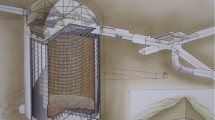Abstract
Q & U Bolometric Interferometer for Cosmology (QUBIC) is an international ground-based experiment dedicated in the measurement of the polarized fluctuations of the Cosmic Microwave Background. It is based on bolometric interferometry, an original detection technique which combines the immunity to systematic effects of an interferometer with the sensitivity of low-temperature incoherent detectors. QUBIC will be deployed in Argentina, at the Alto Chorrillos mountain site near San Antonio de los Cobres, in the Salta Province. The QUBIC detection chain consists in 2048 NbSi transition edge sensors (TESs) cooled to 350 mK.The voltage-biased TESs are read out with time domain multiplexing based on Superconducting QUantum Interference Devices at 1 K and a novel SiGe application-specific integrated circuit at 60 K allowing to reach an unprecedented multiplexing factor equal to 128. The QUBIC experiment is currently being characterized in the laboratory with a reduced number of detectors before upgrading to the full instrument. I will present the last results of this characterization phase with a focus on the detectors and readout system.







Similar content being viewed by others
References
S. Padin et al., PASP 114, 83–97 (2002)
N.W. Halverson et al., Proc. SPIE 3357, 416–423 (1998)
E. Battistelli et al., J. Low Temp. Phys. 199, 482–490, this Special Issue LTD18 (2020). https://doi.org/10.1007/s10909-020-02370-0
D. Mennella et al., Universe 5(2), 42 (2019). https://doi.org/10.3390/universe5020042
C.O. Sullivan et al., SPIE Proc. 10708(107082B), 14 (2018). https://doi.org/10.1117/12.2313332
A. May et al., SPIE Proc. 10708(107083V), 14 (2018). https://doi.org/10.1117/12.2312085
A. Tartari et al., J. Low Temp. Phys. 184(3–4), 739–745 (2016). https://doi.org/10.1007/s10909-015-1398-3
M. Piat et al., J. Low Temp. Phys. 167(5–6), 872–878 (2012)
E.S. Battistelli et al., Astropart. Phys. 34(9), 705–716 (2011). https://doi.org/10.1016/j.astropartphys.2011.01.012
G. D’Alessandro et al., Infrared Phys. Technol. 90, 59–65 (2018). https://doi.org/10.1016/j.infrared.2018.02.008
D. Prêle et al., J. Low Temp. Phys. 193(3–4), 455–461 (2018)
M. Salatino et al., SPIE Proc. 10708(1070845), 12 (2018). https://doi.org/10.1117/12.2312080
S. Marnieros et al., J. Low Temp. Phys., this Special Issue LTD18 (2020). https://doi.org/10.1007/s10909-019-02304-5
Acknowledgements
QUBIC is funded by the following agencies. France: ANR (Agence Nationale de la Recherche) 2012 and 2014, DIM-ACAV (Domaine dInteret Majeur Astronomie et Conditions dApparition de la Vie), CNRS/IN2P3 (Centre national de la recherche scientifique/Institut national de physique nuclaire et de physique des particules), CNRS/INSU (Centre national de la recherche scientifique/Institut national de sciences de lunivers), UnivEarthS Labex program at Sorbonne Paris Cité (ANR-10-LABX-0023 and ANR-11-IDEX-0005-02). Italy: CNR/PNRA (Consiglio Nazionale delle Ricerche/Programma Nazionale Ricerche in Antartide) until 2016, INFN (Istituto Nazionale di Fisica Nucleare) since 2017. Argentina: Secretara de Gobierno de Ciencia, Tecnologa e Innovacin Productiva, Comisin Nacional de Energa Atmica, Consejo Nacional de Investigaciones Cientficas y Tcnicas. UK: the University of Manchester team acknowledges the support of STFC (Science and Technology Facilities Council) grant ST/L000768/1. Ireland: James Murphy and David Burke acknowledge postgraduate scholarships from the Irish Research Council. Duc Hoang Thuong acknowledges the Vietnamese government for funding his scholarship at APC. Andrew May acknowledges the support of an STFC PhD Studentship.
Author information
Authors and Affiliations
Corresponding author
Additional information
Publisher's Note
Springer Nature remains neutral with regard to jurisdictional claims in published maps and institutional affiliations.
Rights and permissions
About this article
Cite this article
Piat, M., Bélier, B., Bergé, L. et al. QUBIC: Using NbSi TESs with a Bolometric Interferometer to Characterize the Polarization of the CMB. J Low Temp Phys 200, 363–373 (2020). https://doi.org/10.1007/s10909-020-02445-y
Received:
Accepted:
Published:
Issue Date:
DOI: https://doi.org/10.1007/s10909-020-02445-y




